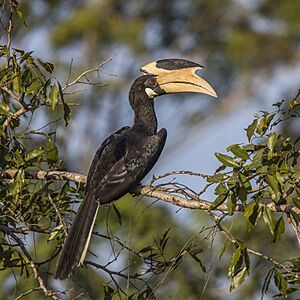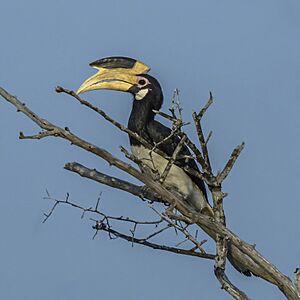Malabar pied hornbill facts for kids
Quick facts for kids Malabar pied hornbill |
|
|---|---|
 |
|
| Male | |
 |
|
| Female | |
| Conservation status | |
| Scientific classification | |
| Genus: |
Anthracoceros
|
| Species: |
coronatus
|
The Malabar pied hornbill (Anthracoceros coronatus) is a large, colorful bird. It is also known as the lesser pied hornbill. This bird belongs to the hornbill family. Hornbills are a group of tropical birds. They are found in many parts of the Old World, like Africa and Asia.
Contents
Understanding the Malabar Pied Hornbill
What is Taxonomy?
Taxonomy is how scientists name and group living things. The Malabar pied hornbill got its scientific name, Anthracoceros coronatus, a long time ago. A Dutch scientist named Pieter Boddaert gave it the name Buceros coronatus in 1783. Later, it was placed in the group called Anthracoceros.
The name Anthracoceros comes from Ancient Greek words. Anthrax means "coal black," and kerōs means "horn." The word coronatus is Latin for "crowned." So, its name means "crowned black horn."
Physical Appearance
The Malabar pied hornbill is a big bird, about 65 cm (25 inches) long. Most of its feathers are black. It has a white belly, a white patch on its throat, and white on the sides of its tail. The back edges of its wings are also white.
Its beak is yellow and has a large, mostly black growth on top. This growth is called a casque. Female hornbills have white skin around their eyes. Males do not have this white skin. Young hornbills do not have a casque yet. These birds weigh around 1 kilogram (2.2 pounds).
Where Malabar Pied Hornbills Live
Habitat and Location
The Malabar pied hornbill lives in India and Sri Lanka. It is a common bird in these areas. You can find them in evergreen forests and moist deciduous forests. They often live near places where people live.
They are found in three main areas in India:
- Central and Eastern India: From West Bengal to parts of Jharkhand, Chhattisgarh, Odisha, Madhya Pradesh, Maharashtra, Andhra Pradesh, and Telangana.
- Western Ghats: Along the eastern slopes and the Konkan belt. This includes parts of Maharashtra, Goa, Karnataka, Tamil Nadu, and Kerala.
- Sri Lanka: Mostly in the low country and dry zone forests. They can also be seen in home gardens.
Life and Habits of the Hornbill
Reproduction and Nesting
During the breeding season, the female hornbill lays two or three white eggs. She lays them inside a hole in a tree. The tree hole is then sealed off with a special "cement." This cement is made from mud, droppings, and fruit pulp.
There is only one small opening left in the nest. This opening is just big enough for the male hornbill to pass food to the mother and her chicks. When the chicks grow too big, the mother breaks out of the nest. She then helps rebuild the wall. After that, both parents feed the chicks.
What They Eat
Malabar pied hornbills eat many different kinds of food. They are omnivores, meaning they eat both plants and animals. Their diet includes fruits, small mammals, birds, small reptiles, and insects. They usually kill their prey and swallow it whole.
Figs are a very important food for them. From May to February, figs make up about 60% of their diet. During the breeding season in March and April, up to 75% of the fruit brought to the nest is figs. They also eat other fruits, even those that are poisonous to many animals.
Hornbills and Their Environment
Malabar pied hornbills are often seen in areas with rich biodiversity. For example, they are found near the Kaiga Atomic Power Station in India. The forests around this plant have many different kinds of rare birds. A study in Dandeli found that their numbers have stayed steady over many years.
Images for kids
-
A female Malabar pied hornbill in flight in Yala National Park, Sri Lanka






